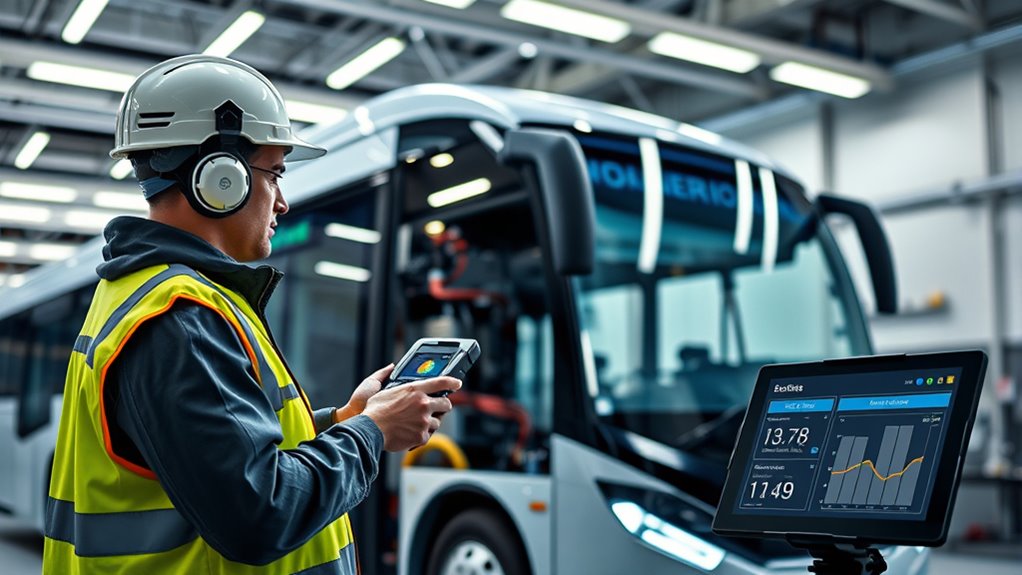Diagnostics are essential for maintaining electric buses because they help you detect faults early and address issues before they cause major disruptions. With real-time monitoring and advanced troubleshooting tools, you can quickly identify problems in batteries, motors, and other components. Proper diagnostics also guide your maintenance planning, reduce downtime, and improve vehicle reliability. By understanding these systems better, you’ll be equipped to keep electric buses running smoothly—if you keep exploring, you’ll uncover even more in-depth insights.
Key Takeaways
- Diagnostics enable early detection of battery, motor, and powertrain issues, preventing costly breakdowns and downtime.
- Real-time monitoring systems provide immediate fault alerts, supporting proactive maintenance and quick troubleshooting.
- Diagnostic tools and software facilitate accurate fault code analysis and system health assessments for efficient repairs.
- Staff training on diagnostic procedures enhances troubleshooting speed and maintenance accuracy.
- Standardized and cybersecurity-enabled diagnostics ensure data integrity, compatibility, and comprehensive vehicle system analysis.

Diagnostics play an essential role in maintaining electric buses efficiently and reliably. When you utilize advanced diagnostic systems, you’re able to identify potential issues before they cause significant disruptions. This proactive approach relies on predictive diagnostics, which use real-time data to detect early signs of component wear or failure.
By doing so, you can schedule maintenance proactively, reducing unexpected breakdowns and downtime. Integrated telematics systems continuously monitor vehicle performance, providing complete insights into various systems, including batteries, motors, and powertrains. This constant surveillance means you’re always aware of your bus’s health, enabling quick responses to emerging issues.
Real-time monitoring is indispensable because it allows you to catch faults early, often before they affect vehicle operation. Whether it’s a drop in battery performance or irregular motor behavior, these systems alert you immediately, so you can intervene promptly. Health monitoring tools further support this effort by offering detailed insights into the condition of critical components. Proper training in diagnostic procedures enhances your team’s ability to interpret system alerts and respond effectively.
For example, you can track battery health, motor efficiency, and other essential systems, ensuring they operate within ideal parameters. When an error occurs, local log files store detailed fault history, making it easier for you or your technicians to analyze the root cause thoroughly. Incorporating cybersecurity measures into diagnostic systems is also crucial to protect vehicle data from potential threats. Additionally, adopting standardized protocols ensures compatibility across different diagnostic platforms and simplifies troubleshooting processes.
Using advanced diagnostic tools enhances your troubleshooting capabilities. Multimeters are essential for measuring electrical continuity and voltage drops safely, especially during physical inspections. Software diagnostics provide in-depth analysis, offering detailed fault codes and system statuses that streamline diagnosis.
Some platforms even enable remote system monitoring, allowing you or support teams to check vehicle health from afar and schedule maintenance before issues escalate. Troubleshooting guides and manuals from OEMs complement these tools by offering step-by-step instructions for resolving specific problems efficiently.
Your staff’s expertise is key in leveraging diagnostics effectively. Proper training ensures they understand pre- and post-inspection routines, emergency procedures, and troubleshooting techniques. Developing local expertise and building strong technical support networks are essential for resolving complex issues quickly.
When you have well-trained staff, maintenance becomes more predictable, and vehicle availability improves. Diagnostics also play a pivotal role in maintenance scheduling. Predictive insights allow you to plan repairs around vehicle usage, avoiding unnecessary servicing and reducing operational costs.
Regular scheduled servicing remains important to maintain peak performance, but diagnostics help you pinpoint the right time for intervention, often remotely scheduling maintenance based on real-time data. Routine checklists and timely diagnostics ensure that issues are addressed before they impact safety or reliability.
Finally, maintaining the specialized equipment involved in diagnostics, such as charging infrastructure and software tools, is key. Multimeters and diagnostic software are indispensable for in-depth electrical analysis, ensuring your electric bus fleet remains in top condition.
Frequently Asked Questions
How Often Should Diagnostics Be Performed on Electric Buses?
You should perform diagnostics on your electric buses regularly, ideally every 3 to 6 months during scheduled maintenance.
On-demand assessments are necessary after abnormal performance or extreme weather events.
Use autonomous tools or real-time telemetry to monitor battery health consistently.
Schedule diagnostics during off-peak times to minimize downtime, and always follow manufacturer recommendations to extend battery life and ensure safety and compliance.
What Are the Common Diagnostic Tools Used for Electric Bus Maintenance?
You’ll find that common diagnostic tools for electric bus maintenance include vehicle-specific options like Proterra Diagnostics, which offer real-time performance data. Generic scan tools are also popular for multi-model fleets.
Network diagnostics are essential too, with CAN bus analyzers and network protocol monitors helping troubleshoot communication issues.
Additionally, multi-brand solutions like JALTEST provide broad compatibility, while specialized software like Rohrer helps analyze vehicle health, ensuring your fleet stays reliable and safe.
Can Diagnostics Predict Future Electric Bus Failures?
Imagine your electric bus as a patient with hidden symptoms. Diagnostics act like a seasoned doctor, predicting failures before they happen.
By analyzing real-time data on battery voltage, temperature, and capacity fade, you can foresee issues like lithium plating or internal shorts.
This proactive approach reduces downtime, saves costs, and keeps your fleet running smoothly, much like preventative care guarantees good health for a long journey ahead.
How Do Diagnostics Improve the Lifespan of Electric Bus Components?
You want to know how diagnostics extend the lifespan of electric bus components. Diagnostics identify early signs of wear and degradation, allowing you to address issues before they worsen.
They help you optimize charging practices, reduce stress on batteries, and prevent overheating. By providing accurate health assessments, diagnostics enable you to maintain components properly, ultimately delaying failure and prolonging your electric bus’s operational life.
Are There Any Safety Concerns When Performing Diagnostics on Electric Buses?
Safety should always be your top priority when performing diagnostics on electric buses. You face risks like electric shocks, arc flashes, and accidental contact with high-voltage components.
To stay safe, use proper PPE, follow strict safety procedures, and make sure systems are de-energized before working.
Regular training, thorough testing tools, and reliable regulations help you prevent hazards, protect yourself, and keep the broader bus operation safe and sound.
Conclusion
By embracing diagnostics, you’ll effortlessly enhance electric bus efficiency and guarantee exceptional safety. Detecting defects early, diagnosing diligently, and deploying data-driven decisions keep your fleet functioning flawlessly. Don’t delay—delve into diligent diagnostics to drive down downtime and deliver dependable transportation. With the right tools and techniques, you’ll stay steps ahead, safeguarding your system’s health and securing sustainable, swift transit. So, seize the science of diagnostics and steer your electric buses toward smarter, safer, and superior service.









